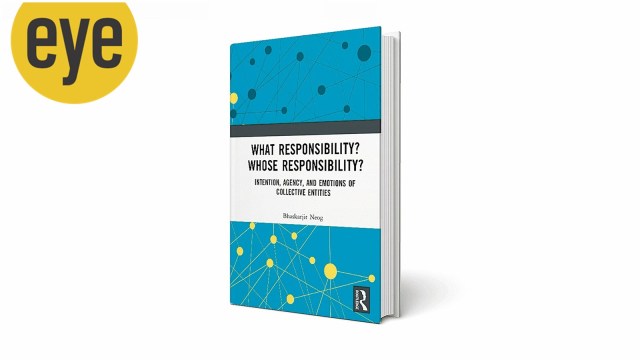Bhaskarjit Neog’s ‘What Responsibility, Whose Responsibility’ analyses the philosophical grounds for ascribing moral agency to groups
Neog argues that collectives can have both intentionality and agency and, therefore, have a sort of personal identity
 Negligence may be a responsibility bearing cause. (Amazon.in)
Negligence may be a responsibility bearing cause. (Amazon.in)Plutarch reports that the sophist Protagoras and the Statesman Pericles once spent a day discussing the cause of an accidental death of a passer by, killed by a javelin thrower at the Olympic Games. What or who killed him? The javelin, the thrower or the organisers, whose poor arrangement led to his death? Like a bullet, we aim to fix responsibility on the one who fired the gun not on the gun. But there are larger questions, touched upon in that ancient debate. What about the person who sold the gun, or the policies that allowed him to sell it? Questions of responsibility do not always stop at the level of individual actors; their instrumentality may be facilitated by organisational negligence.
Negligence may be a responsibility bearing cause. Even here, the blame is fixed on some person(s), as in the Bhopal Gas Tragedy. It is convenient, legally and morally, to blame an individual rather than an organisation, which lacks consciousness, often seen as necessary and sufficient to fix moral responsibility. The further up the causal chain, the more indiscernible and tenuous a singular cause.
Bhaskarjit Neog’s ‘What Responsibility? Whose Responsibility?’ studies the philosophical grounds for ascribing moral agency to groups. He “analyses the moral culpability of collective entities implicated in institutional injustice, corporate scams, organised crimes, gang wars, genocide, xenophobia, and other group-based violence”.
Philosophers usually pin responsibility on the idea of free will: only conscious agents have the freedom to choose. There is no such thing (pace Rousseau and Durkheim or even Hegel) as a group mind. The sum of individuals is not a group. Even groups that are hierarchically organised are composed of individual actors, who may or may not be responsible for what one of them does, even if they are ‘only following orders’ (a defence that did not work in Nuremberg).
But individual actions can often be understood only within a broader social context. Civil unrest, for instance, may enable individuals to take advantage of chaos or suffer its consequences. Were enough steps taken to prevent that protest from turning into a riot? If not, who is responsible? The moral/legal response is usually of the form ‘Heads must roll’, placing responsibility on the determinate actors.
Here, Neog makes an interesting distinction between holding someone morally responsible and punishing them. The International Court of Justice can affix blame on countries, without having the teeth to take action against them. We may blame country A and its leaders for invading country B, without being able to punish them in any way. As one critic of collective responsibility said, ‘You can only wave flags or write poems’.
Granted that there are collectives (structured or unstructured), who is the bearer of collective responsibility? While some collectives like hospitals or municipalities can and have been held responsible for the actions of their employees, without being regarded as morally complicit, there are other cases, where groups or collectives are not easy to regard as agents. If a number of people are killed in a stampede, or drown in a flash flood, who can be held morally responsible?
Neog argues that collectives can have both intentionality and agency and, therefore, have a sort of personal identity, even if its members change over time. A murderous crowd may add or lose individual members as it goes on a rampage but retains its identity and its collective intentions. Elias Canetti, in his classic work, ‘Crowds and Power’, describes what he calls…. “The baiting crowd (which is like)…the hunting pack…it forms with reference to a quickly attainable goal. The goal is known and clearly marked and is also near. This crowd is out for killing and it knows whom it wants to kill. It heads for this goal with unique determination… One important reason for the rapid growth of the baiting crowd is that there is no risk involved… because (it has) immense superiority… no one need fear the sanction attached to killing… (the) permitted murder stands for all the murders people have to deny themselves for fear of the penalties for their perpetration.”
There are many questions, some of which Neog’s thought-provoking book raises about the conduct of and control exercised by, diverse collectives and how the actions of individuals can be attributed not merely to other individuals but the collective itself, which can be held morally responsible.
For those burdened with having to deal with corporate entities (banks, service providers, online platforms), the pursuit of individuals, who act on their behalf is often a Kafka-esque nightmare. Even when we know who to blame, we often need to cross the border that separates the instrument from the organisation that wields it and the even larger opaque structure ultimately responsible. More theoretical work needs to be done before we can answer the question of how such groups can be thought of as morally culpable agents and treated accordingly.
(The writer is a retired professor at St. Stephen’s College)
- 01
- 02
- 03
- 04
- 05































